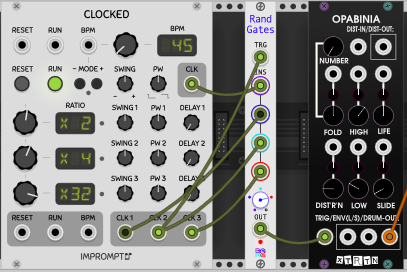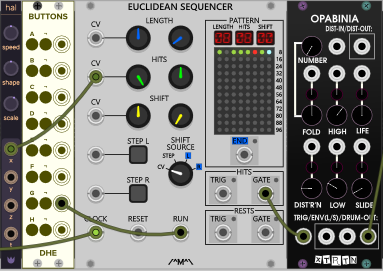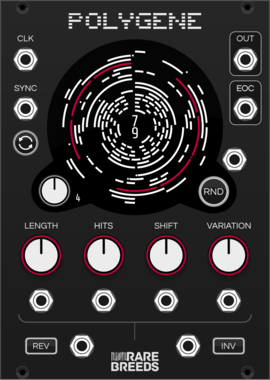Hey guys! I was looking for ways to breakcore and do random drums, and i found diferents ways to do that, but I wonder if is there any module or way to randomize just one gate for example to control a gate that is used for a snare. What I want is that every time that gate opens, do it by differents subdivisions, like transforming the first gate into a second different one. For example: A bernoulli gate controlling a kick and a snare at the same time, and the gate of the snares being modificated to make glitchy snares or making differents subdivisions times. I am being clear? Thank you for let me ask!
If I understand you correctly you are looking for a burst generator, which turns gates into bursts of multiple gates. This one is really great for that:
I did something similar to what you are describing in this video (at the right side of the middle row):
I used a bernoulli gate to randomly trigger the bursts and merged it back together with the other output to trigger random slices of a sample, but I only used one kind of burst here, if you want to generate different bursts you could also modulate the time and repeat of the burst generator.
You could use a switch to change between different clocks?
Also Nysthi has Ratchet.
Also take a look at XTRTN modules and dedicate some time to Mononeura or Ichneumonid.
An example of switching (almost) randomly between four various clocks and sending it to a drum module. (See the ARRIVE and DEPART knobs to influence the probability of choices.)

(Edit: hmmm, it’s not exactly what you asked for.)
Another fun (and even more chaotic) way to choose from the different clocks is Sha#Bang’s RandGates.

(Edit: hmmm, it’s not exactly what you asked for.)
OK, so it’s still not perfectly what you need but we’re getting closer. I’m manually sending a gate to Switch 8-1 that is set to 'randomly select from its clock inputs. (Please see DIRECTION knob set respectively.)
Actually I have to admit that probably Schabbes’ original suggestion is the best. Take a look at the burst generator modules.
burst generator for additive. bernouli gate for subtractive. turing machine (pulses) for neutral random; somewhere in between the two previous. mix, match, chain them together.
very nice! this is very useuful!
i tried some ways you adviced me and is working, but a new problem comes out, and is that snare and kick are overlaping, and I want the kick and the snares being separated each time, even if there is a burst on the snare. any idea of making this? well i,m a huge fan of venetian snares, aphex twin, and break core and I want to program stuff like that
Oh, there are lots of logic modules to choose from. But the one I recommend is this. Let’s say input A is kick, input B is snare.

Just one more and I shut up. Promise.

I’m sending manually a gate to the RUN input of the handy Count Modula Euclid module. To avoid boring rhythms I use a tricky LFO to change the number of steps through the HITS input. How do you like this one @pedrotomba? ![]()
hello Schabbes, `
thanks for sharing your technique, but just by looking at the youtube screen, i can’t really understand precisely how you get it.
Do you think you can share your patch (via patchstorage.com for example), or sand me by mp ?
ps : by the way, i discover your channel, very very nice music, i’m a fan !!
Hi! Thanks!
I’m not sure if I can find that patch now, besides that it is driven by a beatstep pro, so it wouldn’t play by itself…
But the technique is not very complicated:
I send a gate pattern from the Beatstep pro to a Bernoulli Gate, one output is connected to the burst module and then combined with the other output with a logic module, using “OR” logic, which does the same as just mixing both together again, so the result is the same gate pattern as before, but with occasional bursts here and there.
This Gate pattern triggers the Play button of Simpliciter, which plays a drumloop in grid mode. At the same time a random module (“Quincunx”) is triggered by the original gate pattern to play a random slice of the sample for each trigger, but play the same slice a couple of times when a burst comes.
so…
Gate pattern → Bernoulli Gate output B → Burst module → Mix together with output A → Trigger Sampler
And then the gates are also connected to an envelope and the second random output modulates a filter, which is also mapped to a midi controller that I wiggle a bit… and then some more drum samples come in from NYSTHI MusicalBox on the left… 
I can give you an example file… just put it back together myself here…
random bursts example.vcv (18.3 KB)
The sample I used is gaz-singsing-112.5bpm.wav from this free sample pack:
ok, i got it !
thank’s a lot and continue what you do !
Great topic. I have learned in my experience good gate signal flow is key. I like to start with a high resolution (highly multiplied clock). I find it gives you better basis to divide and create musical patterns with. View it like creating a bust. Sculptures don’t get a minuscule amount of marble and then hope it expands to give them a lot of material to work with. You start with a block and you alter it to create what you want. You need material, gates in this instance, and chipping it down is infinitely more effective than trying to impose on it something that isn’t there. I’d recommend starting with a master clock which is the fastest time division you could possible imagine needing, than move it one notch faster, in case you are wrong in what you think you need. This is setting a limit with randomization, determining as too the fastest thing that with probability and division will play.
Think about basic clock division. Say you have a sixteenth note clock. If you divide it by three, that clock will obviously be slower, but it will also move a sixteenth note increment faster each time it is divided, 4-3 = 1.
I’d suggest for getting a fast clock, just use the clocked module. Multiply to the fastest timing you could possibly need. Now modules to manipulate this clock.
Most of the work with gate processing will be handled by division and randomization. Randomization is usually done on a basic level by saying here is a gate, what percentage of the time does it pass (bernoulli gates). Division is just playing a clock at a different interval than what is inputted (less frequently, but based on math).
Patterns JW (clock divider with the ability to “or” and “xor” multiple divisions with lots of randomization and rotation options) Rgate bogaudio (simple, cv controllable, clock divider) Clocked random gates Count modula (Multi channel Bernoulli gate) Marbles by audible instruments (has a cv section, but those are derived from the gates section which though simple, is very powerful. Don’t overlook the jitter control which is essentially taking the internal or external clock source, multiplying it a lot, and offsetting based on this very high resolution to create randomization. Higher jitter in a sense the further it will stray from the internal or external clock).
Swing is an entirely different subject. The most common type of swing is triplet swing. This essentially divides a quarter note into six equal divisions (similar to a high resolution clock) It then divides these so you are using this high resolution clock, to draw from and grab swing notes into the main beats.
But then again, in terms of breakcore music. I doubt these artists are calculating all the mayhem in terms of clocking everything. They are most likely getting a high resolution clock, manipulating it and using things such as samplers and granular processors to get something desirable. I’d recommend simpliciter and supercell in vcv to do this kind of stuff. Effects with a buffer, will just grab what you already have, and when you learn how to manipulate them, spit it back out in interesting ways. If you think about it I doubt breakcore artists, are clocking everything. I rather believe they are grabbing samples, and sequencing them to where they sound good. The thought process isn’t "man this sounds great, I am so happy i divided my clock by 3 ord with 5 and sent through a bernoulli gate and then turned on for half a second. I think they most likely are using modular to create interesting ideas and then recording it all and sequencing in a daw.
TLDR: Get a high resolution clock, divide (rotating is also great), randomize. Most of this kind of glitchyness comes from audio processing and experimenting, recording, and then sequencing. There is no one clock that generate instant breakcore.
I know your post is a couple of years old now, but this is such an interesting topic that I couldn’t help but chime in. Hopefully, you’ve found a solution by now, but just in case, or for anyone else scrolling through older threads, I’ve got some thoughts. As a fun suggestion, you could introduce an element of controlled randomness by mimicking a d20 roller. I know it sounds a bit off the wall, but hear me out. You could roll d20 online using a site like flipsimu.com, and each number rolled corresponds to a specific gate setting or subdivision for your snare. You could jot down the results and manually set your gate timings based on those rolls for a set period.
Another idea might be to split the poly output (triggers or gates) of Rare Breeds’ Polygene, and switch between them with ML Modules’ Sequential Switch 8 to 1 with a clock pulse into the Rand input.
By itself this would not switch between, say, snare and kick, but it would give a really complex rhythm for either of them.



